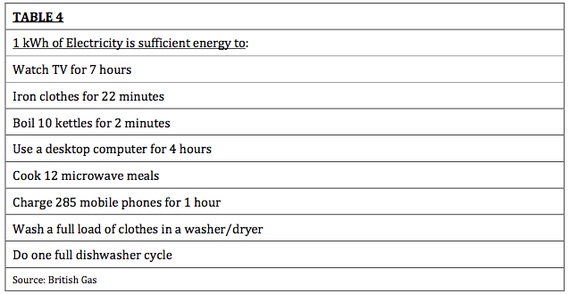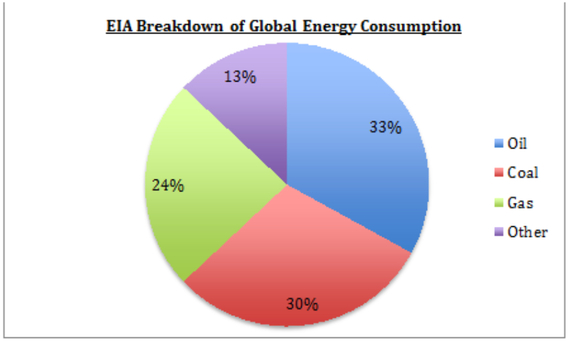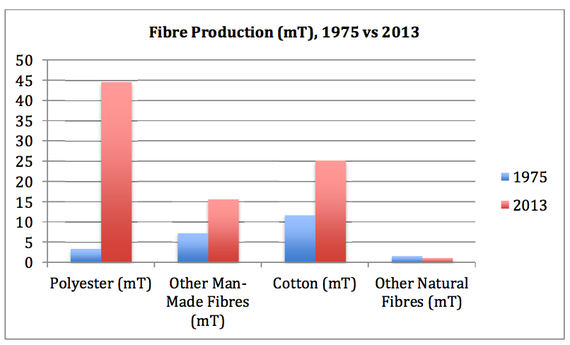A better understanding about the shocking environmental implications of low-cost garment production may finally move customers to push companies into improving their ethics, pay and working conditions.
That's because the environment directly affects the customer, and any children they have or intend to have. Presently, customers are more likely to encourage more of the cost profits to be passed onto the manufacturers.
To put the environmental impact into perspective:
All this serves to release toxic chemicals into our air, water and soil. It also results in the creation of greenhouse gases and depletes our water and fossil fuel energy resources.
Fabric Production
Each year close to 90mT of fabric are produced. This consumes 1.5 trillion kWh of electricity. Table 4 below puts that consumption into context:
![2015-08-19-1439995397-8345815-TABLE4.jpg]()
The energy life cycle of one single 100% cotton t-shirt consumes around 30kWh.
According to the EIA (Energy Information Administration) fossil fuels account for 87% of global energy consumption. Coal accounts for 33%. This is considered the 'dirtiest' of the fuels given its use in electricity production releases sulphur dioxide, nitrogen oxide (which causes respiratory problems) and toxic heavy metals (such mercury, lead and cadmium).
![2015-08-19-1439995561-7221117-RWTABLE4.jpg]()
Coal is the primary source of energy in China & India, accounting for around 70% of each country's energy needs. Collectively China and India account for over 50% of the world's annual coal consumption. They use coal to produce electricity.
These countries are the world's largest producers of textiles at US$274bn and US$40bn of exports respectively for 2013. As highlighted in the following chart, polyester (over 50%) and cotton (around 30%) account for the bulk of fibre production.
![2015-08-19-1439995713-1444032-TABLEFIBRE.jpg]()
Cotton is grown and uses large-scale industrial processes. Its production is chemically and water-intensive. The chemicals it uses are agrochemicals - herbicides, pesticides, insecticides, fertilisers, etc - many of which are not absorbed by the plant but which disperse into the air or leach into the soil and water. Cotton production requires a great deal of water - 6400-15,500 litres per pound of cotton. Most (around 70%) of global cotton uses irrigated water, i.e. it is not rain-fed. This leads to depletion of water resources.
Water consumption is already outpacing population growth. Over the next 10 years water demand is expected to grow by 40% versus population growth of around 10%. This implies that ⅔ of the world's population could be living in areas categorised as water-stressed. Post cultivation cotton also undergoes various processes to create yarns suitable for textile production. Again this requires energy and chemicals, including sodium hydroxide (which increases water acidity).
Polyester production has grown considerably - by an average of 7% per year since 1975. Its main raw material is petroleum. Therefore its production leads to a depletion of fossil fuels. It requires a large amount of energy. 1 tonne of spun polyester requires 29,000-35,000 kWh of energy. The equivalent amount of cotton requires around 7,000 kWh. Polyester is also a larger emitter of CO2. It emits 7.2-9.5kg/tonne of fibre versus cotton which emits and equivalent 2.35-5.89kg
Once the base products have been converted into yarns, those yarns are then woven or knitted into textiles. This, again, requires energy, water (e.g. for repeated dye baths) and chemicals (e.g. for bleaching, dyeing, printing, finishing).
Around 200 tonnes of water is required per tonne of manufactured textiles. The average textile manufacturing facility uses 1.6m litres of water per day.
In 2010, 7 trillion litres of water were used in global textile production. According to the WHO (World Health Organisation) 17-20% of all industrial water pollution resulted from textile dyeing and finishing.
Around 8,000 chemicals are used in the various textile production processes. The main problem with many of these chemicals is that they can be carcinogens, contain heavy metals and can be slow to biodegrade.
Unsurprisingly water effluent from textile factories is highly toxic. This is partly because not all the chemicals fix to the fibres during processing. Instead they end up in the wastewater pipe.
China is an example of where air and water pollution resulting from industry has proven a major social and political issue.
Garment Manufacturing & Distribution
Manufacturing requires machinery which again consumes energy.
There is also the issue of fabric waste. Around 15% of fabric is wasted during the garment manufacturing process. Once produced garments need to be transported. Globalisation has resulted in wide transport footprints certainly for larger brands.
For example, cotton can be grown in Egypt, the textile can be woven in China and the manufacturing can be undertaken in Indonesia. Globalisation has also resulted in trade across continents. For example, of the clothing sold in the US and UK at least 95% is imported. Again, transport requires energy via lorry, rail, ship, aeroplane and each releases CO2 along with other emissions.
When garments are delivered to a brand they will then subsequently be distributed to various retail outlets. Aside from the resulting transport energy needs, each of these outlets will consume energy in the form of heating, lighting, etc. Packaging and marketing materials will also be required.
Customer Ownership
Once a customer has bought a garment they may or may not choose to wear it. If they don't wear it the energy consumed along the process and up to the point of delivery to the customer has effectively been wasted.
There will also be the associated energy required to dispose of it (see later section). However if the customer does choose to wear the garment then washing, drying or dry cleaning will need to be accounted for. Each consumes water and energy. Indeed this part of the garment's life cycle can account for up to 80% of a garment's carbon footprint.
Based on an average 400 loads per year the average washing machine consumes around 75,000 litres of water.
Also to be borne in mind are the chemicals, e.g. laundry detergents and softeners which generally end up in wastewater. These chemicals are often resistant to water treatment. The shedding of fibres during washing, especially from synthetic materials, can also add to chemical waste accumulation.
Washing machines also require energy - electricity from coal or other fossil fuels. Around 90% of this energy is used to heat the water during the wash. Drying using a machine is the most energy-intensive step during the customer ownership period. Dry cleaning uses chemical solvents which again can be difficult to eliminate.
Disposal
At the end of a garment's life the customer can either donate/recycle their clothes or dispose of them. It is interesting to note that, in the UK, only around 15% of unwanted clothes are donated or recycled. The balance - 85% - ends up in landfills.
Around 80% of landfill ends up being incinerated. Again this consumes energy. For the balance decomposition of organic materials releases methane. Methane is 20 times more powerful than CO2 in terms of climate change. Landfills, of course, emit other toxins.
As the saying goes - waste not, want not.
That's because the environment directly affects the customer, and any children they have or intend to have. Presently, customers are more likely to encourage more of the cost profits to be passed onto the manufacturers.
To put the environmental impact into perspective:
- The fashion industry is the world's second most polluting industry, after oil.
- 25% of the world's chemicals are used for textile production.
- Around 10% of the world's global carbon emissions result from the apparel & textile industry.
- The textile industry uses more water than any other industry apart from agriculture.
All this serves to release toxic chemicals into our air, water and soil. It also results in the creation of greenhouse gases and depletes our water and fossil fuel energy resources.
Each year close to 90mT of fabric are produced. This consumes 1.5 trillion kWh of electricity. Table 4 below puts that consumption into context:

The energy life cycle of one single 100% cotton t-shirt consumes around 30kWh.
According to the EIA (Energy Information Administration) fossil fuels account for 87% of global energy consumption. Coal accounts for 33%. This is considered the 'dirtiest' of the fuels given its use in electricity production releases sulphur dioxide, nitrogen oxide (which causes respiratory problems) and toxic heavy metals (such mercury, lead and cadmium).

Coal is the primary source of energy in China & India, accounting for around 70% of each country's energy needs. Collectively China and India account for over 50% of the world's annual coal consumption. They use coal to produce electricity.
These countries are the world's largest producers of textiles at US$274bn and US$40bn of exports respectively for 2013. As highlighted in the following chart, polyester (over 50%) and cotton (around 30%) account for the bulk of fibre production.

Cotton is grown and uses large-scale industrial processes. Its production is chemically and water-intensive. The chemicals it uses are agrochemicals - herbicides, pesticides, insecticides, fertilisers, etc - many of which are not absorbed by the plant but which disperse into the air or leach into the soil and water. Cotton production requires a great deal of water - 6400-15,500 litres per pound of cotton. Most (around 70%) of global cotton uses irrigated water, i.e. it is not rain-fed. This leads to depletion of water resources.
Water consumption is already outpacing population growth. Over the next 10 years water demand is expected to grow by 40% versus population growth of around 10%. This implies that ⅔ of the world's population could be living in areas categorised as water-stressed. Post cultivation cotton also undergoes various processes to create yarns suitable for textile production. Again this requires energy and chemicals, including sodium hydroxide (which increases water acidity).
Polyester production has grown considerably - by an average of 7% per year since 1975. Its main raw material is petroleum. Therefore its production leads to a depletion of fossil fuels. It requires a large amount of energy. 1 tonne of spun polyester requires 29,000-35,000 kWh of energy. The equivalent amount of cotton requires around 7,000 kWh. Polyester is also a larger emitter of CO2. It emits 7.2-9.5kg/tonne of fibre versus cotton which emits and equivalent 2.35-5.89kg
Once the base products have been converted into yarns, those yarns are then woven or knitted into textiles. This, again, requires energy, water (e.g. for repeated dye baths) and chemicals (e.g. for bleaching, dyeing, printing, finishing).
Around 200 tonnes of water is required per tonne of manufactured textiles. The average textile manufacturing facility uses 1.6m litres of water per day.
In 2010, 7 trillion litres of water were used in global textile production. According to the WHO (World Health Organisation) 17-20% of all industrial water pollution resulted from textile dyeing and finishing.
Around 8,000 chemicals are used in the various textile production processes. The main problem with many of these chemicals is that they can be carcinogens, contain heavy metals and can be slow to biodegrade.
Unsurprisingly water effluent from textile factories is highly toxic. This is partly because not all the chemicals fix to the fibres during processing. Instead they end up in the wastewater pipe.
China is an example of where air and water pollution resulting from industry has proven a major social and political issue.
Manufacturing requires machinery which again consumes energy.
There is also the issue of fabric waste. Around 15% of fabric is wasted during the garment manufacturing process. Once produced garments need to be transported. Globalisation has resulted in wide transport footprints certainly for larger brands.
For example, cotton can be grown in Egypt, the textile can be woven in China and the manufacturing can be undertaken in Indonesia. Globalisation has also resulted in trade across continents. For example, of the clothing sold in the US and UK at least 95% is imported. Again, transport requires energy via lorry, rail, ship, aeroplane and each releases CO2 along with other emissions.
When garments are delivered to a brand they will then subsequently be distributed to various retail outlets. Aside from the resulting transport energy needs, each of these outlets will consume energy in the form of heating, lighting, etc. Packaging and marketing materials will also be required.
Once a customer has bought a garment they may or may not choose to wear it. If they don't wear it the energy consumed along the process and up to the point of delivery to the customer has effectively been wasted.
There will also be the associated energy required to dispose of it (see later section). However if the customer does choose to wear the garment then washing, drying or dry cleaning will need to be accounted for. Each consumes water and energy. Indeed this part of the garment's life cycle can account for up to 80% of a garment's carbon footprint.
Based on an average 400 loads per year the average washing machine consumes around 75,000 litres of water.
Also to be borne in mind are the chemicals, e.g. laundry detergents and softeners which generally end up in wastewater. These chemicals are often resistant to water treatment. The shedding of fibres during washing, especially from synthetic materials, can also add to chemical waste accumulation.
Washing machines also require energy - electricity from coal or other fossil fuels. Around 90% of this energy is used to heat the water during the wash. Drying using a machine is the most energy-intensive step during the customer ownership period. Dry cleaning uses chemical solvents which again can be difficult to eliminate.
At the end of a garment's life the customer can either donate/recycle their clothes or dispose of them. It is interesting to note that, in the UK, only around 15% of unwanted clothes are donated or recycled. The balance - 85% - ends up in landfills.
Around 80% of landfill ends up being incinerated. Again this consumes energy. For the balance decomposition of organic materials releases methane. Methane is 20 times more powerful than CO2 in terms of climate change. Landfills, of course, emit other toxins.
As the saying goes - waste not, want not.



















